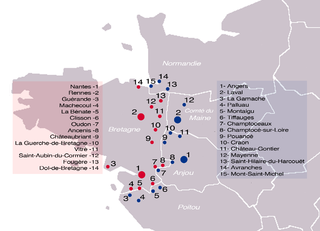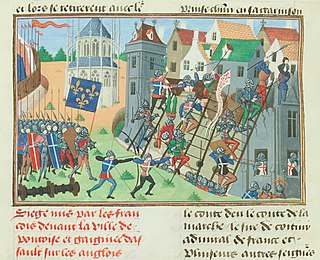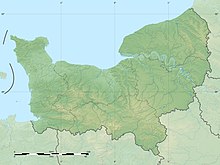
John IV the Conqueror KG, was Duke of Brittany and Count of Montfort from 1345 until his death and 7th Earl of Richmond from 1372 until his death.

John V, sometimes numbered as VI, bynamed John the Wise, was Duke of Brittany and Count of Montfort from 1399 to his death. His rule coincided with the height of the Hundred Years' War between England and France. John's reversals in that conflict, as well as in other internal struggles in France, served to strengthen his duchy and to maintain its independence.

Arthur III, more commonly known as Arthur de Richemont, was briefly Duke of Brittany from 1457 until his death. He is noted primarily, however, for his role as a leading military commander during the Hundred Years' War. Although Richemont briefly sided with the English once, he otherwise remained firmly committed to the House of Valois. He fought alongside Joan of Arc, and was appointed Constable of France. His military and administrative reforms in the French state were an important factor in assuring the final defeat of the English in the Hundred Years' War.

The now-extinct title of Earl of Richmond was created many times in the Peerage of England. The earldom of Richmond was initially held by various Breton nobles; sometimes the holder was the Breton duke himself, including one member of the cadet branch of the French Capetian dynasty. The historical ties between the Duchy of Brittany and this English earldom were maintained ceremonially by the Breton dukes even after England ceased to recognize the Breton dukes as earls of England and those dukes rendered homage to the King of France, rather than the English crown. It was then held either by members of the English royal families of Plantagenet and Tudor, or English nobles closely associated with the English crown. It was eventually merged into the English crown during the reign of Henry VII of England and has been recreated as a Dukedom.

The Battle of Formigny, fought on 15 April 1450, was a major battle of the Hundred Years' War between England and France. A decisive French victory that destroyed the last significant English field army in Normandy, it paved the way for the capture of their remaining strongholds.

The Battle of Morlaix was fought in Morlaix on 30 September 1342 between the Anglo-Breton and Franco-Breton forces in Brittany. The Anglo-Breton under English command besieged the town, but a Franco-Breton relief force arrived. The English constructed a strong defensive position. After repeated attacks, the French forced the English to retreat into the woods, and the French force then withdrew.

The Battle of Caen was an assault conducted on 26 July 1346 by forces from the Kingdom of England, led by King Edward III, on the French-held town of Caen and Normandy as a part of the Hundred Years' War.

Sir Thomas Rempston II was a medieval English soldier, landowner, and a leading military commander during the Hundred Years' War in France. He dedicated his career, as his father had done before him, to the service of the House of Lancaster, the ruling dynasty of England. Much of the Rempston family's fortunes were in fact owed to this. However, several ransoms contracted by Sir Thomas while campaigning in France, coupled with the fact that his long-living mother held many of his estates in dower, meant that he had to endure several financial difficulties for much of his life.
The Treaty of Amiens, signed on 13 April 1423, was a defensive agreement between Burgundy, Brittany, and England during the Hundred Years' War. The English were represented by John, Duke of Bedford, the English regent of France, the Burgundians by Duke Philip the Good himself, and the Bretons by Arthur de Richemont, on behalf of his brother the Duke of Brittany. By the agreement, all three parties acknowledged Henry VI of England as King of France, and agreed to aid each other against the Valois claimant, Charles VII. It also stipulated the marriage of Bedford and Richemont to Burgundy's sisters, in order to cement the alliance.

The Loire Campaign was a campaign launched by Joan of Arc during the Hundred Years' War. The Loire was cleared of all English and Burgundian troops.

The French–Breton War lasted from 1487 to 1491. The cause of this war was the approaching death of the Breton Duke Francis II of Brittany, who had no clear successor. If not resolved, this meant a resumption of issues from a previous War of the Breton Succession (1341–1364), which had rival claimants allying with England or France, resulting in an ambiguous peace treaty that failed to prevent future succession disputes.

The sieges of Vannes of 1342 were a series of four sieges of the town of Vannes that occurred throughout 1342. Two rival claimants to the Duchy of Brittany, John of Montfort and Charles of Blois, competed for Vannes throughout this civil war from 1341 to 1365. The successive sieges ruined Vannes and its surrounding countryside. Vannes was eventually sold off in a truce between England and France, signed in January 1343 in Malestroit. Saved by an appeal of Pope Clement VI, Vannes remained in the hands of its own rulers, but ultimately resided under English control from September 1343 till the end of the war in 1365.

The siege of Tartas in Gascony was an engagement between English and French forces in the late stages of the Hundred Years' War. It was undertaken by English forces and their Gascon subjects against Charles II of Albret, a powerful nobleman in southwestern France. Albret was hostile to the English and his presence in Gascony caused much trouble to the English in the region, thereby raising the need to strike against him. The bulk of hostilities only lasted up until early 1441: the siege had dragged on inconclusively, and peace terms were agreed between the attackers and defenders. The ceasefire was extended several times until mid-1442 as both sides awaited further support from England and France.

The siege of Pouancé of 1432 was undertaken by John V, Duke of Brittany, against his nephew John II, Duke of Alençon, as part of a conflict involving the payment of a dowry. It is at times referred to as the third siege of Pouancé, in succession to other sieges in 1066 and 1379.
Gilles of Brittany was a Breton prince and Lord of Chantocé. He was the son of John V of Brittany and Joan of France, and the younger brother of the dukes Francis I and Peter II.
Events from the year 1458 in France
Lancaster's chevauchée of 1356 in Normandy was an English offensive directed by Henry, Duke of Lancaster, in northern France during 1356, as a part of the Hundred Years' War. The offensive took the form of a large mounted raid – a chevauchée – and lasted from 22 June to 13 July. During its final week the English were pursued by a much larger French army under King John II that failed to force them to battle.

The siege of Pontoise took place during the Hundred Years War. French forces led by King Charles VII of France besieged and captured the last English stronghold in Île de France, eliminating the English threat to Paris.

The siege of Breteuil was the investment of the Norman town of Breteuil, held by partisans of Charles II, King of Navarre, by French forces. It lasted from April to about 20 August 1356. It was interrupted on 5 July when a small English army commanded by Henry, Earl of Lancaster relieved and resupplied it. The French king, John II, attempted to bring Lancaster to battle with the much larger French royal army, but Lancaster marched away and the attempt failed. John then renewed the siege of Breteuil.

Louis de Laval was a French nobleman, soldier, politician and bibliophile.



















